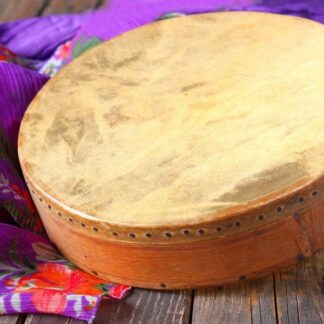Top Tips for Selecting a Hand Drum

">
Hand drumming is an exciting activity. Unique from other drums, which utilize drumsticks, they’re an active, full-body experience. If you’re looking to purchase your very own hand drum but you aren’t sure what to look for, here are our top tips for selecting a hand drum.
Good Condition and Materials
Condition
One of the first things you’ll want to examine is the state of the drum’s body and head. If either is in poor condition, it can affect the instrument’s appearance, overall longevity, and sound. Check for any noticeable cracks on the drum’s body. Dents and cracks—despite being unseemly appearance-wise—don’t typically affect the drum’s sound. However, ensure that no cracks are stretching unnaturally close to the instrument’s skin.On the other hand, damage to the drum’s skin—or head—can be devastating. Splits, holes, and excessive age will affect the quality of the drum’s sound. Due to the lowered quality and increased breakability, faulty drumheads require immediate replacement. Check for the drumhead’s level of dryness. If it’s completely dried out, tuning will be difficult, if not impossible. Check for any dips or warps in the skin’s surface as well to ensure it’s perfectly even.
Materials
Another top tip for selecting a hand drum is to consider the material. The skin can be specifically suited to different needs. Some drums are designed for players with smaller, more fragile hands, while others are suited to a wide variety of hand types.When it comes to selecting the material, you’ll want to choose between either natural or synthetic drumhead skins. Natural materials such as rawhide or cowskin are nice to look at, and they produce warmer, stronger, more authentic tones. However, they’re susceptible to environmental and climate changes, and they might be less suited for people who intend to play their hand drums exclusively outdoors. Synthetic materials are less affected by the weather and temperature, but they produce sharper, less natural tones.
The Right Sound
The ideal type of sound heavily depends on personal preference. To find the right type of drum to suit your needs, you’ll want to consider its size, shape, and material. Each of these qualities can have a significant affect on the type of sound the instrument will make.If you have the opportunity, test out the drum prior to purchasing it. Evaluate the sound and how it feels to use it. If you’re not content, try a different size, shape, or material.
Suitability for Personal Needs
Apart from ensuring the instrument meets your personal tastes in appearance, build, and sound, you’ll want to make sure it’s well-suited for its environment. Drums that are going to be housed or played outdoors will need to be sturdier and built of more durable materials. You can be less picky with an indoor drum because most materials hold up well to indoor conditions. If you plan to frequently move your drum from place to place, consider purchasing one that’s lightweight and simple to transport.Here at Tachini Drums, we sell a wide variety of authentic, masterfully crafted Native drums. If you’re looking for
Native American hand drums for sale, come check out our inventory.
 ">
">